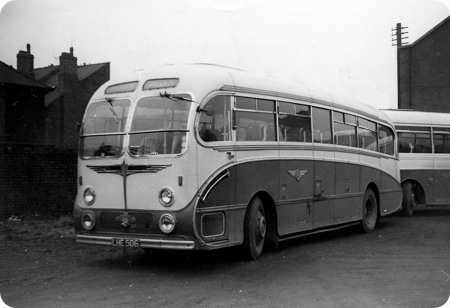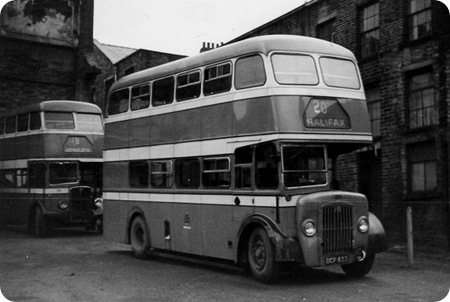
County Motors
1964
Leyland Titan PD3A/1
Roe H42/31F
Another County Motors of Huddersfield vehicle this time a Leyland Titan PD3A/1. The PD3 indicated that the bus was 30 foot long rather than 27 foot of which all the PD2s were. The A after the 3 indicates an enclosed radiator made mainly of fibre glass and this style was introduced after consultation with St Helens Corporation. The 1 after the 3A indicates that the gear box was of the normal synchromesh type rather than the Pneumo-Cyclic direct selection type.
County Motors were taken over by Yorkshire Traction in 1968 and this bus became fleet number 745 with them. There is a photo of this bus in the Yorkshire Traction livery here unfortunately it seems to have lost the bottom half of its radiator.
A full list of Titan codes can be seen here.
———
Re the comment about the radiator grill. These were only a fibreglass moulding and were prone to being broken – for example by conductors standing on them to change the destination. Yorkshire Traction simply modified them when necessary by substituting a mesh panel instead.
Andrew
———
This was one of a pair of PD3As which replaced a pair of ill fated Guy Wulfrunians which went to West Riding. Yorkshire Traction bought PD3s with Northern Counties or Willowbrook bodies. However a 1965 batch carried Roe bodywork to a Park Royal design similar to those supplied on AEC chassis to East Kent. The Yorkshire Traction livery suited the lines of the Roe body and these were a pair of handsome machines
Chris Hough
———
Handsome indeed – but they were traditional Roe bodies!
Yorkshire Traction only ever had three batches of PD3s from new. The first two Northern Counties, the last the Roes (on Park Royal frames) – which still managed to look better proportioned than the almost identical contemporary Sheffield Regent Vs with "real" Park Royal bodies.
The only Willowbrook deckers in the fleet were the RHE…G registered Atlanteans which were a diverted order from Devon General, delivered initially in Devon General livery.
David Oldfield
———
David, I seem to remember that there were four of the diverted Devon General Atlanteans. They appeared very frequently in Leeds on the Yorkshire Traction services and I found them fascinating. The colours were most pleasing and, although I never rode on one, I have an impression that the interiors and the seats were in blue – can anyone please confirm this ??
Chris Youhill
———
I think you’re right about the numbers, Chris, and almost certainly about the interiors. Blue was the then standard for Devon General. Prior to nationalisation, Devon General was a superbly presented fleet and the difference in shades of red and cream between Devon General and Yorkshire Traction made an interesting comparison.
David Oldfield
Quick links to the - Comments Page - Contact Page - Home Page

Photo by ‘unknown’ if you took this photo please go to the copyright page.
Yorkshire Traction
1957
Leyland Tiger Cub PSUC1/2
Burlingham ‘Seagull’ C41F
If you go back to a previous posting at this link you will be able to compare the difference between this ‘Yorkshire Traction Seagull’ bodywork and the ‘Ribble Seagull’ . The main difference that strikes me is the Horizontal split windscreen and slightly different lighting arrangement. Is this a Mk 2 or Mk 3? Maybe they are both Mk 3s and in the one year age gap improvements to the screen were made. If you know, let me know, leave a comment.
06/03/13 – 16:46
This Seagull is a Mark V. This was available with either front or central entrance and replaced the central entrance Mark III and forward entrance Mark IV. The distinguishing feature of the Mark V from the models it replaced was the single piece rear windscreen with rear quarter lights. The Mark V was produced for the 1957 and 1958 seasons. The windscreen arrangement was optional on the Mark IV, V and VI, either single piece flat screens or horizontally split. For example, Ribble had Mark IV and Mark VI Seagulls with flat screens, whilst North Western, Trent, Wallace Arnold and Yelloway (at least) had Mark V Seagulls with flat screens.
David Williamson
Quick links to the - Comments Page - Contact Page - Home Page

Halifax Corporation Transport and Joint Omnibus Committee
1954
Daimler CVG6
Roe H33/25R
This bus is a ‘CV series Daimler the ‘V’ stands for Victory meaning the chassis was built after World War II whereas the preceding series ‘CW’ was for chassis built during the War when the ‘W’ stood for war.
As this bus is a ‘CV’ series it had what was called a ‘Birmingham Tin Front’, similar to the previous K.H.C.T. AEC Regent III. If it had been a CS/CC series built 1955 onwards the radiator would of been different, and would then of been called a ‘Manchester Front’. Is there a Tin/Fibre Glass front expert out there that can sort out this radiator business once and for all. When does a ‘Birmingham’ become a ‘Manchester’.
There is a link to a video of a preserved Halifax Daimler ‘CV’, all be it two years younger than this bus here please note the difference in the destination boxes from the bus in this photo and the one in the video, more on that at a later date.
A full list of Daimler codes can be seen here.
———
The Manchester front is the one with the headlamp mounted on the wing, the bonnet itself being narrower than the Birmingham version. It took a Mancunian to realise that short drivers couldn’t see the nearside wing on a Birmingham front so they were forever bashing things!
The Birmingham front was also fitted to Crossleys, Guy Arabs and AEC Regent IIIs, whereas the Manchester type only ever appeared on Daimlers. There are two versions of the Manchester front, as CVG6s had a tapering front chassis frame with a 7′ 6" front axle. CVG6-30s, CCGs & CSGs and the last few CVG6s all had straight frames and 8ft axles, hence a wider front.
David A Jones
———
29/05/11 – 07:51
Sadly these buses weighed a ton more than the mark III Regent and had 112bhp engines in lieu of 125bhp of the mark III as a result they had a lot of trouble, many were fitted with Leyland O.600 units and later 95 had a 6LXB Gardner whilst 93 had a turbo charged Daimler. So 95 became CVG6LX, 93 CVD6, most of the others CVL6 some retained the 6LW mainly the 116 etc group used on the flatter shorter corporation services.
Christopher
Quick links to the - Comments Page - Contact Page - Home Page



